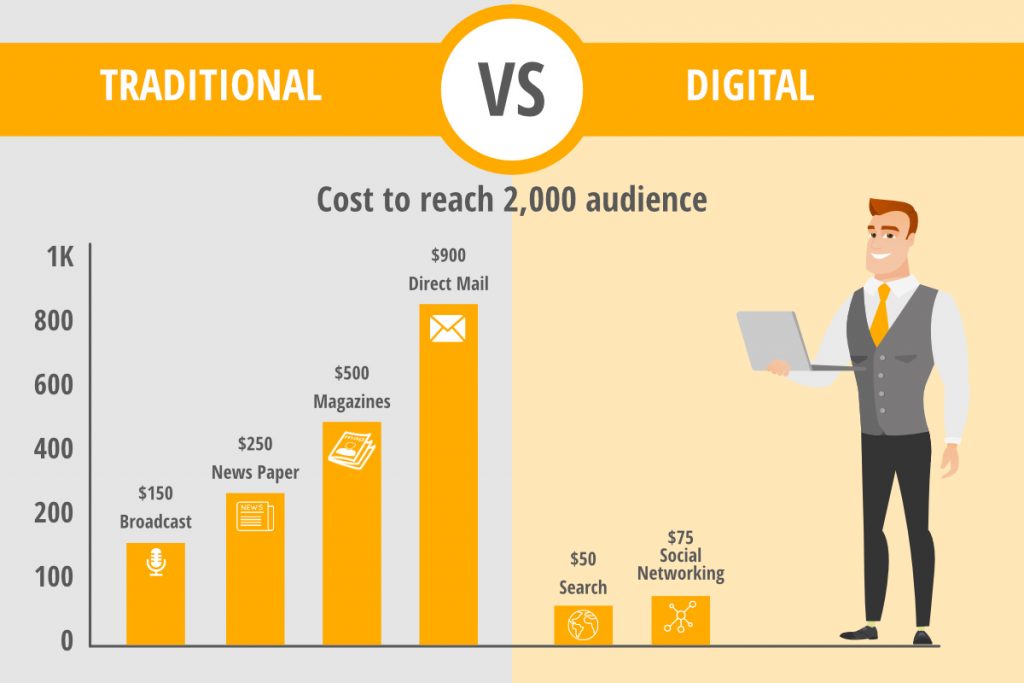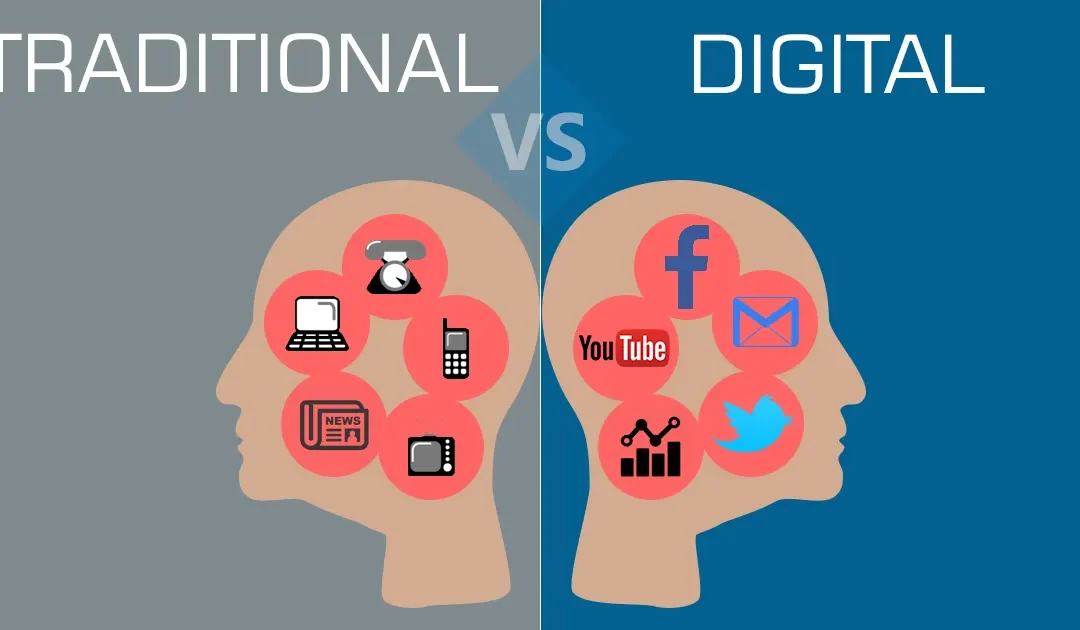As we step into 2025, business leaders are once again evaluating the best avenues to reach and influence their audiences. The marketing landscape has evolved significantly over the last decade, and the choice between traditional vs digital marketing is no longer black and white. While both approaches have their advantages, understanding where to invest your marketing budget requires a clear grasp of each method’s strengths, limitations, and relevance to current consumer behavior.
At Creative Digital Technologies, we specialize in guiding businesses through this decision-making process with data-driven strategies and modern digital solutions. In this in-depth guide, we explore the current state of both traditional and digital marketing, analyze their effectiveness in today’s climate, and offer practical insights on how to allocate your marketing budget in 2025 for maximum impact.
Key Marketing Trends Shaping 2025:
To determine the best investment approach, it’s important to understand the key trends influencing marketing in 2025. Consumer expectations are evolving rapidly, and technology is at the forefront of this transformation.
- Personalized User Experience
Customers now expect brands to deliver highly personalized interactions. Digital marketing enables tailored messaging, retargeting, and behavior-based automation that create customized user journeys and boost engagement rates. - Rise of Voice Search and AI
With the proliferation of smart assistants and voice-enabled devices, optimizing for voice search is no longer optional. Digital content strategies must now consider conversational search queries and voice-activated browsing behaviors. - Video as a Dominant Format
Short-form and live video content continue to dominate user engagement across platforms like YouTube, TikTok, and Instagram. Video marketing has proven to be one of the most effective tools for storytelling, brand awareness, and conversion. - Hybrid Experiences: The ‘Phygital’ Era
Marketing strategies that integrate physical and digital experiences are gaining traction. QR codes, virtual product experiences, and interactive installations bridge the gap between traditional touchpoints and digital platforms. - Sustainability and Brand Values
Today’s consumers are values-driven. They prefer brands that reflect ethical practices and contribute to social causes. Digital marketing offers the flexibility to share brand stories authentically, respond to real-time issues, and highlight sustainability initiatives.

Performance Breakdown: Comparing Traditional and Digital Marketing
To better understand the practical distinctions between both strategies, consider the following comparative breakdown:
Traditional Marketing:
- Reach: Broad, ideal for mass awareness
- Credibility: High perceived trustworthiness, especially via TV and print
- Longevity: Print and billboard ads may remain visible for extended periods
- Limitations: High cost, difficult to measure results, and limited personalization
Digital Marketing:
- Targeting: Advanced segmentation by demographics, interests, and behaviors
- ROI Tracking: Comprehensive analytics tools enable accurate measurement
- Flexibility: Campaigns can be tested, paused, or optimized in real-time
- Customer Engagement: Enables two-way conversations and personalized communication
- Limitations: Requires technical expertise and may face trust barriers like ad fatigue or privacy concerns
Both channels have their place, but digital marketing’s superior ability to adapt, track, and convert has made it the preferred choice for brands aiming for scalable growth.
Defining the Landscape: Traditional Marketing in a Modern Context
Traditional marketing refers to long-established advertising methods such as television, radio, print media, direct mail, and outdoor advertising. These channels operate primarily through offline mediums and offer broad, mass-market exposure. For decades, traditional marketing dominated the advertising space, creating powerful brand impressions across wide audiences.
Even in today’s digital age, traditional marketing retains a degree of relevance, especially in industries where consumer trust and mass recognition are critical. Local businesses, luxury brands, and legacy organizations still use traditional channels to reinforce credibility and reach less tech-savvy demographics. Despite its declining dominance, traditional marketing provides a valuable layer of brand visibility when used strategically.
However, traditional marketing is limited in two significant ways: measurement and targeting. Unlike digital channels, it’s difficult to track engagement, response rates, and conversion metrics with precision. This lack of actionable data makes it harder to optimize campaigns or justify return on investment.
When to Use Traditional vs. Digital: Strategic Investment Scenarios
To determine where to invest in 2025, businesses should assess their goals, audience, and available resources. Here are two categories where each marketing approach shines:
Best Use Cases for Traditional Marketing
- Building Local Awareness – Flyers, direct mail, and local radio are still effective in community outreach.
- Brand Credibility – National TV or print ads create a perception of authority and trust.
- Reaching Offline Audiences – Certain demographics (e.g., older generations) respond better to traditional formats.
Best Use Cases for Digital Marketing
- Lead Generation and Sales – PPC and SEO drive targeted traffic with high conversion potential.
- Brand Growth on a Budget – Social media and email marketing offer scalable strategies for startups and SMEs.
- Data-Driven Decision Making – Digital analytics enable smarter investments through A/B testing and performance monitoring.
- Expanding Global Reach – Digital channels break geographic barriers, allowing international exposure.
Allocating Your 2025 Marketing Budget Wisely
Investing wisely in 2025 doesn’t mean choosing sides—it means strategically combining both marketing forms where appropriate. Businesses should lean heavily on digital marketing for its performance, affordability, and data capabilities while leveraging traditional methods for brand reinforcement and local visibility.
Here’s a professional recommendation for different business types:
- Startups & Small Businesses: Focus on digital-first strategies to build awareness and generate leads efficiently.
- Established Enterprises: Use a hybrid model. Combine digital campaigns with traditional tactics like sponsorships or magazine features for credibility.
- Local Service Providers: Invest in both—optimize for local SEO while using community-based print and radio ads to remain top-of-mind.
- E-Commerce Brands: Go fully digital. Prioritize mobile optimization, performance marketing, influencer partnerships, and retargeting.
Digital Marketing: The Data-Driven Powerhouse
Digital marketing encompasses all marketing efforts that utilize the internet and digital devices. It includes channels such as search engine optimization (SEO), pay-per-click advertising (PPC), social media marketing, content marketing, email campaigns, affiliate marketing, and more. Digital marketing allows brands to reach highly specific audiences with tailored messages, while simultaneously tracking real-time performance across every touchpoint.
The true strength of digital marketing lies in its scalability, agility, and measurability. Whether you’re a small startup or an enterprise-level organization, digital marketing can be customized to fit your budget, industry, and growth objectives. You gain the ability to test campaigns in real-time, adjust based on performance data, and connect with consumers through multiple stages of the buyer journey—from awareness to conversion.
Moreover, digital platforms empower businesses to create interactive, two-way communication channels with their audiences. From social media engagement to personalized email sequences, digital strategies enable continuous customer relationship management that traditional advertising cannot match.

Why Creative Digital Technologies is Your Ideal Marketing Partner in 2025?
Navigating the ever-changing marketing landscape requires a partner who understands both traditional roots and modern advancements. At Creative Digital Technologies, we help businesses develop customized strategies that align with current trends, consumer behavior, and business goals.
Our core services include:
- Strategic SEO and content development
- Full-funnel digital advertising (Google Ads, Meta Ads, etc.)
- Conversion-focused web design and development
- Social media growth strategies
- Analytics, insights, and campaign optimization
More than just a service provider, we act as an extension of your team—committed to transforming your vision into measurable results. Our goal is simple: to make your brand thrive in a competitive digital era.
A New Era Demands a Balanced Approach:
In 2025, marketing success is defined not by the channels you choose, but by how effectively you use them to connect with your audience. While traditional marketing still offers strategic advantages, especially in specific industries and locations, digital marketing provides unparalleled agility, precision, and ROI.
The smartest investment you can make this year is in a strategy that evolves with your audience. Whether that means refining your SEO, launching a high-converting ad campaign, or integrating online and offline experiences, the future belongs to brands that adapt intelligently.

